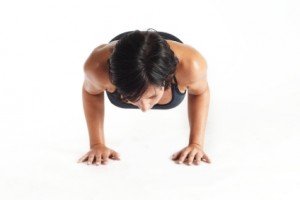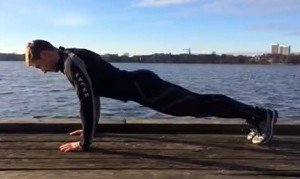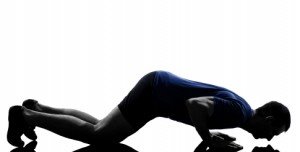Most of us have never had the pleasure of learning proper push-ups. Here are five common mistakes – and how to avoid them.
Many people make one of these 5 cardinal push-up mistakes:
- Shoulder pain during push-ups? You are probably making mistake # 1.
- Back pain with push-ups? Read mistake # 2.
- Wrist pain doing pushups? Error # 4.
- No or poor training progress ? Read mistakes # 3 and # 5.
Today you will find out whether you are making one of the 5 most common push-up mistakes, and – if so – how you can fix it quickly and sustainably.
Why very few people learn correct push-ups
Have you ever seen fourth graders do pushups? That’s really cute!
Also because the form is often beyond good and bad. Now everyone starts small.
Most of us learned push-ups in elementary school.
Unfortunately, many technical errors from this time crept in and solidified.
This reduces the yield in training:
- Less training effect,
- less muscle growth,
- less definition.
In addition, it often leads to pain during push-ups: in wrists, shoulders or intervertebral discs.
If I have learned one thing in 20 years of training in various fitness studios, it is:
Push-ups with perfect shape are as rare as stars in a stormy sky.
It’s a shame actually. But it’s very easy to solve. Here are the 5 most common push-up mistakes – and how to avoid them.
Learn push-ups: the 5 most common mistakes (and how to avoid them)
Push-up Mistake 1 – Your elbows are pointing outward

Imagine if I were to film you in fitness coaching from a bird’s eye view while you are doing push-ups.
Would your upper arms form a “T-shape” with your torso?
If so, I wouldn’t be surprised: Many fourth graders learn this push-up technique.
Unfortunately, this posture has a serious disadvantage: You put excessive strain on your rotator cuff – and that can lead to injuries.
TIP: If the child has already fallen into the well and you have pain when doing a push-up in the shoulder area, you will find out here what you can do for healthy shoulders.
Solution for perfect push-up technique

Keep your elbows as close to your body as possible.
Imagine you were pressing yourself vertically upwards under your armpit.
On the one hand, you challenge your chest and triceps – hey, who wants nice arms?
You also train your upper and middle back (latissimus and trapezius muscles) and even your biceps – while relieving your shoulder joints.
You are having trouble getting used to it?
Then do the push-ups on your fists. In such a way that the palms of the hands face each other – i.e. both backs of the hands outwards. The wrists are stretched out.
Alternatively, you can also take a bench or step that you hold onto. If you position your hands this way, you will notice how unnatural it feels when you spread your elbows.
Push-up mistake 2 – You “sag”

Your head, upper back, and hips should be in a straight line throughout the push-ups.
If you “sag” in your hips, you unconsciously accept two disadvantages:
- You are cheating on the training effect in the core (abdominal muscles and hip extensors).
- You risk overloading the lumbar spine and back pain.
Solution for perfect push-up technique
Pinch your buttocks!
Imagine holding a marble with your bum.
During the entire exercise.
There is a simple trick that you can use to learn correct push-ups and train what this body tension feels like:
- Position yourself in the push-up so that your heels press against a wall.
- During the push-ups, you press your heels “into the wall”.
You will notice how your butt tightens up. That is exactly the tension that you want to keep.
Push-up mistake 3 – You rely on gravity
Don’t just plop you down on the floor like a wet rag.
Then it would be no wonder if the training progress was a long time coming.
Solution for perfect push-up technique
Imagine that you dipped your palms into the ground.
Now you use the strength in your arms to “pull” you down to the ground. Just like with the bent-over barbell row.
This gives you another advantage:
You also train the muscles of your upper back.
Yes, this also makes you stronger. Because the additional muscle tension when lowering acts like a spring, which releases its energy again in the upward movement.
Push-ups Mistake 4 – You don’t stretch your wrists

Many people sooner or later get wrist pain from push-ups.
Why?
In everyday life you rarely hyperextend your wrists as much as when doing a push-up.
That is why there is often a lack of mobility.
Fortunately, the solution is very easy.
Solution for perfect push-up technique
Stretch and mobilize your wrists between training sets to relieve them.
How to EXTEND your wrists:
- Pause on all fours – so that the back of your hand touches the floor.
- Your fingers are now pointing towards your feet.
- Your wrists are now in the opposite direction bent as with a push-up.
- Hold this position for 20 seconds.
How to MOBILIZE your wrists:
- Fold your hands so that the fingers are interlocked and the palms are touching.
- Rotate your wrist 15 times alternately clockwise and counterclockwise.
Push-ups mistake 5 – You are doing push-ups raised or on your knees

You have been training push-ups on your knees or with a raised upper body for a long time and you can’t get any further?
The most common cause of errors is due to the “simpler” variants:
So far you have trained your pectoral muscles at a different angle than when doing the “real push-up” on the floor.
That’s why it was so difficult for you to get fit for the original.
But you can learn the jump to the right push-up, like this …
Solution for perfect push-up technique
Change your push-up technique by adding an intermediate step between knee and original push-ups, the four-legged push-up
You start in the starting position with your knees bent, the quadruped stand.
This is the same position as with the knee push-up – with the difference that you first lift your knees 5-10 cm from the floor.
The stronger you get, the further you move your feet backwards.
Until you can do a regular push-up.
Conclusion: the perfect push-up?
Learning Proper Pushups: I believe proper pushups with clean technique should be part of every school curriculum.
As long as this remains a dream of the future, we help ourselves by correcting our mistakes ourselves. With the 5 most common technical mistakes in push-ups, you will become your own fitness coach and on the best way to the perfect push-up.
The classic push-up is still too difficult or too easy for you? Do you want to know how to do one-arm push-ups? Perhaps you are also wondering whether it means push-ups, push-ups or push-ups? Or would you like to hear the story of a little boy who started doing push-ups when he was 16 and got into strength training? Then you should read on here now.

